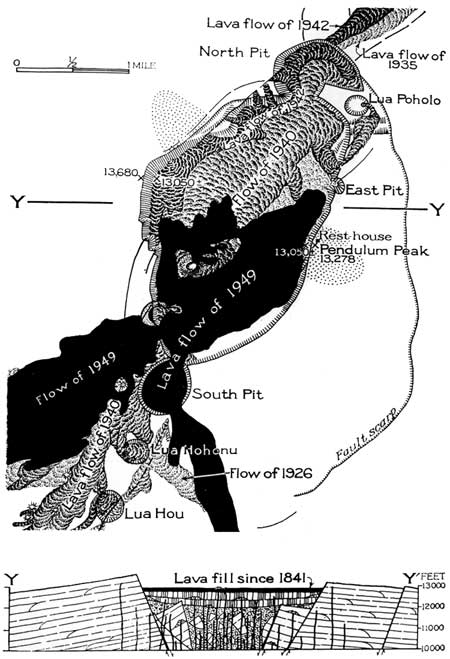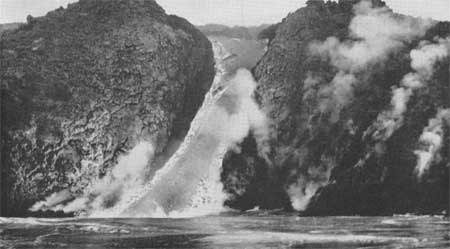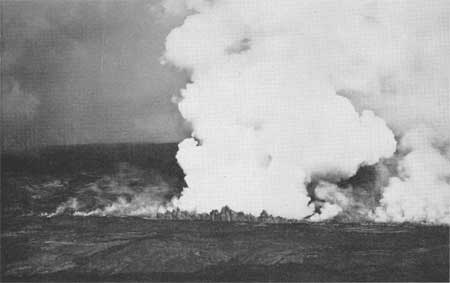|
HAWAII NATURE NOTES
THE PUBLICATION OF THE
NATURALIST DIVISION, HAWAII NATIONAL PARK
AND THE HAWAII NATURAL HISTORY ASSOCIATION
MAUNA LOA, FIERY COLOSSUS OF THE PACIFIC
DESCRIPTION. Mauna Loa is the world's largest active
volcano and probably the largest single mountain of any sort on earth.
It rises 13,680 feet above sea level, and approximately 30,000 feet
above its base at the ocean floor. Its volume is of the order of 10,000
cubic miles, as compared to 80 cubic miles for the big cone of Mount
Shasta in California. This huge bulk has been built almost entirely by
the accumulation of thousands of thin flows of lava, the individual
flows averaging only about 10 feet in thickness.
In form, Mauna Loa is a very broad flat dome, the
slopes of which nowhere are steeper than about 12°. Similar slopes
extend outward beneath the water all the way to the sea floor. This type
of volcano is known as a shield volcano. At the summit of Mauna
Loa is an oval depression 3 miles long, 1.5 miles wide, and as much as
600 feet deep (Plates 8 and 9). This depression, commonly called "the
crater" but more properly termed a caldera, was formed by insinking of
the summit of the mountain. Its name is Mokuaweoweo. At the
northern and southern ends Mokuaweoweo coalesces with smaller nearly
circular pits formed in a similar manner (see Figure 3). Southwest of
the caldera there are two more of these pit craters, named Lua
Hou (New Pit) and Lua Hohonu (Deep Pit).
TABLE 2
Eruptions of Mauna Loa1
(After Stearns and Macdonald, 1946)
|
Date of
commencement |
Approximate
duration
(days) |
Location of
principal
outflow |
Altitude of
main vent
(feet) |
Approximate repose
period since last
eruption (months) |
Area of
lava flow
(square miles) |
Approximate
volume of lava
(cubic yards) |
| Year | Month
and
day |
Summit
eruption | Flank
eruption |
|
| 1832 | June 20 | 21 | (?) |
Summit | 13,000(?) | -- |
-- | -- |
| 1843 | Jan. 9 | 5 | 90 |
N. flank | 9,800 | 126 |
20.2 | 250,000,000 |
| 1849 | May | 15 | -- |
Summit | 213,000 | 73 |
-- | -- |
| 1851 | Aug. 8 | 21 | (?) |
Summit | 13,300 | 26 |
6.9 | 90,000,000 |
| 1832 | Feb. 17 | 1 | 20 |
NE. rift | 8,400 | 6 |
11.0 | 140,000,000 |
| 1855 | Aug. 11 | -- | 450 |
do. | 10,500(?) | 41 |
312.2 | 150,000,000 |
| 1859 | Jan. 23 | <1 | 300 |
N. flank | 9,200 | 26 |
432.7 | 4600,000,000 |
| 1863 | Dec. 30 | 120 | -- |
Summit | 13,000 | 73 |
-- | -- |
| 1868 | Mar. 27 | 1 | 515 |
S. rift | 3,300 | 23 |
49.1 | 4190,000,000 |
| 1870 | Jan. 1(?) | 14 | -- |
Summit | 13,000 | 21 |
-- | -- |
| 1871 | Aug. 1(?) | 30 | -- |
do. | 13,000 | 18 |
-- | -- |
| 1872 | Aug. 10 | 660 | -- |
do. | 13,000 | 11 |
-- | -- |
| 1873 | Jan. 6 | 2(?) | -- |
do. | 13,000 | 3 |
-- | -- |
| 1873 | Apr. 20 | 547 | -- |
do. | 13,000 | 3 |
-- | -- |
| 1875 | Jan. 10 | 30 | -- |
do. | 13,000 | 2 |
-- | -- |
| 1825 | Aug. 11 | 7 | -- |
do. | 13,000 | 6 |
-- | -- |
| 1876 | Feb. 13 | Short | -- |
do. | 13,000 | 6 |
-- | -- |
| 1877 | Feb. 14 | 10 | 71 |
W. flank | -180± | 12 |
-- | -- |
| 1880 | May 1 | 6 | -- |
Summit | 13,000 | 38 |
-- | -- |
| 1880 | Nov. 1 | -- | 280 |
NE. rift | 10,400 | 6 |
24.0 | 300,000,000 |
| 1887 | Jan. 16 | -- | 10 |
SW. rift | 5,700 | 65 |
411.3 | 4300,000,000 |
| 1892 | Nov. 30 | 3 | -- |
Summit | 13,000 | 68 |
-- | -- |
| 1896 | Apr. 21 | 16 | -- |
do. | 13,000 | 41 |
-- | -- |
| 1899 | July 4 | 4 | 19 |
NE. rift | 10,700 | 38 |
16.2 | 200,000,000 |
| 1903 | Oct. 6 | 60 | -- |
Summit | 13,000 | 50 |
-- | -- |
| 1907 | Jan. 9 | <1 | 15 |
SW. rift | 6,200 | 37 |
8.1 | 100,000,000 |
| 1914 | Nov. 25 | 48 | -- |
Summit | 13,000 | 94 |
-- | -- |
| 1916 | May 19 | -- | 14 |
SW. rift | 7,400 | 16 |
6.6 | 80,000,000 |
| 1919 | Sept. 29 | Short | 42 |
do. | 7,700 | 40 |
49.2 | 4350,000,000 |
| 1926 | Apr. 10 | Short | 14 |
SW. rift | 7,600 | 77 |
813.4 | 4150,000,000 |
| 1933 | Dec. 2 | 17 | <1 |
Summit | 13,000 | 91 |
2.0 | 100,000,000 |
| 1935 | Nov. 21 | <1 | 42 |
NE. rift | 12,100 | 23 |
913.8 | 160,000,000 |
| 1940 | Apr. 7 | 133 | <1 |
Summit | 13,000 | 51 |
103.9 | 100,000,000 |
| 1942 | Apr. 26 | 2 | 13 |
NE. rift | 9,200 | 20 |
1110.6 | 100,000,000 |
| 1943 | Nov. 21 | 3 | -- |
Summit | 13,000 | 18 |
(?) | (?)13 |
| 1949 | Jan. 6 | 145 | 2 |
do. | 13,000 | 61 |
5.6 | 77,000,000 |
| 1950 | June 1 | <1 | 23 |
SW. rift | 8.000 | 12 |
1435.0 | 14600,000,000 |
|
| Total |
| 1,328 | 1,352 |
|
|
|
251.8+ | 4,037,000,000+ |
1The duration for most of the eruptions previous to 1899 is
only approximate. Heavy columns of fume at Mokuaweoweo, apparently
representing copious gas release accompanied by little or no lava
discharge, were observed in January 1870, December 1887, March 1924,
November 1941, and August 1944. They are not indicated in the
table.
2Upper end of the flow cannot be identified with
certainty.
3Area above sea level. The volume below sea level is unknown,
but estimates give the following orders of magnitude:
1850—300,000,000 cubic yards; 1868—100,000,000 cubic yards;
1887—200,000,000 cubic yards; 1915—200,000,000 cubic yards;
1926—1,500,000 cubic yards. These are included in the volumes given
in the table.
4All eruptions in the caldera are listed at 13,000 feet
altitude, although many of them were a little lower.
5Flank eruption started April 7.
6Activity in the summit caldera may have been essentially
continuous from August 1872 to February 1877, only the must violent
activity being visible from Hilo.
7Submarine eruption off Kealakekua, on the west coast of
Hawaii.
82.5 square miles of this is the area of the thin flow near
the summit. An unknown area lies below sea level.
9About 0.5 square mile of this is covered by the thin flank
flow above the main cone and 0.8 square mile is in Mokuaweoweo
Caldera.
102.8 square miles is in Mokuaweoweo caldera and 1.1 square
miles outside the caldera.
122.8 square miles of this is covered by the thin flank flow
near the summit, and 0.5 square mile is in the caldera.
13Amount of lava liberated probably small; eruption was largely
a liberation of gas.
14Preliminary determination.
|
From the caldera at the summit of the mountain there
extend outward two prominent zones of fracturing—rift zones.
The rift zones are marked at the surface by many open fissures and
cinder and spatter cones built during eruption by the
accumulation of spatter and fragments of lava thrown into the air as
fountains of liquid lava at the source of lava flows. Some of the gobs
of liquid lava solidify in the air, and pile up into loosely cemented
cinder cones upon striking the ground. Others that are still liquid when
they strike the ground stick together and form spatter cones. One rift
zone extends southwestward from Mokuaweoweo caldera, and the other
northeastward toward the city of Hilo. A much less definite rift zone
extends northward toward the Humuula Saddle, between Mauna Loa and Mauna
Kea. On a clear day the profile of the northeast rift zone of Mauna Loa
can be seen from the vicinity of Park Headquarters as a succession of
hills (cinder cones). The most prominent of these is Puu Ulaula (Red
Hill), at an altitude of 10,000-feet, which is 200 feet high on its
downhill side. A rest house, located in one side of this cone, provides
shelter for travelers enroute to and from the summit.

FIGURE 3. Map of cross-section of Makuaweoweo caldera after the 1949
eruption. Lua Poholo, East Pit, and Lua Hohonu are pit craters formed
since 1941. (Modified after Stearns and Macdonald, 1946, click on
image for an enlargement in a new window).
The fresh flows of aa lava extending downslope from
the rift zones appear black. The fresh pahoehoe flows may also appear
black, but when light is reflected from them they appear silvery gray
from a distance. Older lavas are dark gray, and still older ones
reddish-brown. Lava flows commonly divide, leaving within their
boundaries small "islands" of older land not covered by the new lava.
These islands are known in Hawaii as kipukas. From the vicinity
of Kilauea caldera the slopes of Mauna Loa show many variations in
color, depending on the age and surface characteristics of the different
flows. On the upper slopes of the mountain the newer black flows
surround kipukas of older gray or brown lava. On the lower slopes the
kipukas show as clumps of large trees, such as Kipuka Ki on the Mauna
Loa truck trail, or Kipuka Puaulu, in which Bird Park is situated.

PLATE 3. A stream of liquid rock gliding smoothly into the sea is
recorded by a photographer who faced extreme heat to come within 100
feet of shore. Mauna Loa eruption, June 1950. (Hawaii Air National
Guard).
The growth of Mauna Loa was not entirely
uninterrupted. On its south eastern slope, a short distance west of
Hawaii National Park, is an area that received no new lava flows for
many thousands of years. There stream erosion carved big valleys into
the mountainside. The remains of these big valleys and the ridges that
separated them can still be clearly seen inland from Pahala and Punaluu,
although the valleys have been partly filled by new lava flows.
As the great cone of Mauna Loa approached its present
size it appears to have become somewhat unstable. There is a tendency
for the rocks to break along certain lines and for the blocks seaward
from the breaks to slide outward and downward toward the ocean. These
breaks are known as faults and the cliffs formed on the land
surface by the movements as fault scarps. A prominent series of
fault scarps, partly buried by later lava flows, lies just northwest of
the road from Park Headquarters to Pahala. The faults are still active,
and are the source of many earthquakes recorded on the seismographs of
the Hawaiian Volcano Observatory.
Extending inland from South Point, the Kahuku Pali is
a large fault scarp marking the edge of a downsunken area on the
southwest rift zone.

PLATE 4. 1950 lava flow of Mauna Loa approaching the sea. Many acres
of ohia forests and several buildings were destroyed by this eruption,
the first to strike the sea since 1926, when the village of Hoopuloa was
covered (Plate 10). (Hawaii Air National Guard).
ACTIVITY OF MAUNA LOA. Throughout the past century
Mauna Loa has been one of the most active volcanoes on earth. It has
erupted on an average of once every 3-1/2 years, and its eruptions
during that period have poured out a total of more than 3-1/2 billion
cubic yards of lava. The eruptions can be classified as summit
eruptions—those that occur in and near the summit caldera and
flank eruptions—those that occur lower on the flanks of the
mountain, generally on one of the rift zones. Probably all flank
eruptions begin with brief activity at the summit, followed after a few
hours of quiet by the outbreak on the flank.
A typical eruption of Mauna Loa begins with the
opening of a fissure or series of fissures, as much as 13 miles long
(Plate 5). From this fissure liquid lava squirts in a nearly continuous
line of low fountains, from a few feet to 50 feet high. This very
spectacular manifestation has been called the "curtain of
fire." From the fountains pour copious fast-moving floods of lava,
and along the fissure lava spatter builds up a nearly continuous wall, a
few feet high, known as a spatter rampart. The "curtain of fire"
is short-lived. generally lasting less than a day. The upper and lower
ends of the fissure then become inactive, and eruption is restricted to
a few hundred yards of the central part of the fissure. The lava
fountains increase in height, reaching as high as 800 feet (Plate 2),
and debris from the fountains accumulates around them to form a cinder
cone. Pumice and Pele's hair (natural spun glass) rain down on the
country to leeward of the vents. A great cloud of yellowish-brown gas
rises several thousand feet above the fountains. The principal flows of
lava issue during this stage, which may continue for weeks or even
months. Some of these flows reach the shore, and may be destructive
(Plate 10). Eventually the abundant gas liberation and high lava
fountains come to an end, and the final phase of the eruption consists
of a relatively quiet outpouring of lava. It usually is short, lasting
only a few hours, but it may continue for several weeks, as in the 1949
eruption.

PLATE 5. Lava fountains up to 300 feet high along Mauna Loa's
southwest rift, June 1950. Most of the 1950 lava was produced by these
fountains. (United States Air Force).
|

